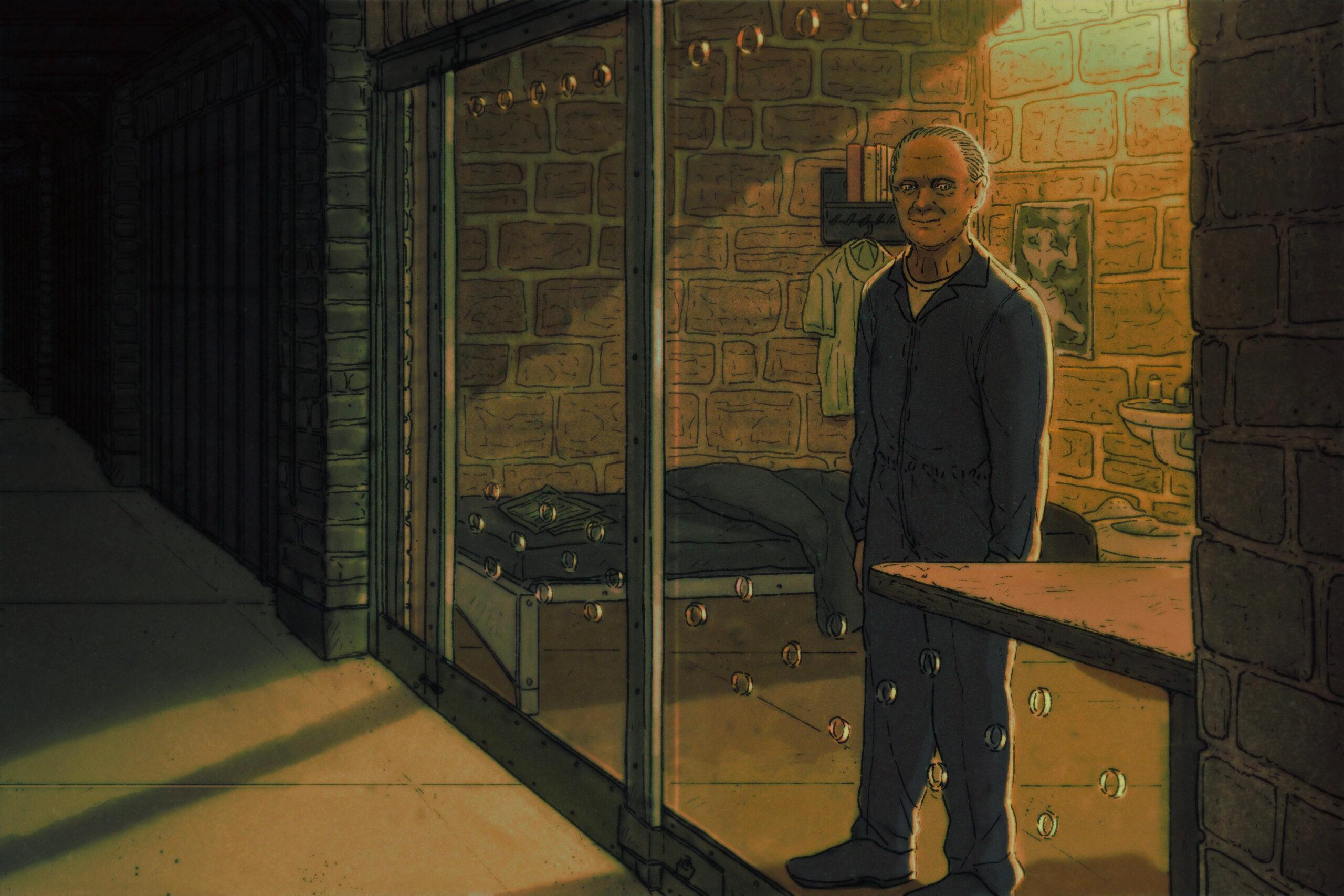
With CBS debuting Clarice on Thursday night—and the 30th anniversary of The Silence of the Lambs arriving just three days later—The Ringer is spending a day celebrating Hannibal Lecter and his strangely intoxicating universe.
I’m trying to work out how many people I’ve killed. Fifty thousand? Could be more. I’ve never kept count. I have different ways of doing it. I like to go with my mood. Lately, I’ve been very into stealth. I find myself creeping around, blending in, trying to take out my target without anyone noticing. Give me a yacht party, a disguise, and a little poison, and I’m happy. Other times, I like to make a little more noise. I’ve charged through enemy lines tossing grenades like Mardi Gras beads. I’ve sprayed flames from my hands and roasted my victims to ash. I’ve stolen Lamborghinis and plowed them into innocent crowds. I’ve cut people down with lightsabers. Recently, I went through a phase where I’d gun an enemy down, then use telekinesis to pick up his body and beat one of his allies to death with it. Actually, I’m not sure I technically killed anyone in that instance. My enemies were possessed by some kind of transdimensional evil plague (I’ve forgotten the details). The sound of their bodies hitting the floor was pretty human, though.
Oh, I’m talking about imaginary people here. Should I have said that sooner? All my victims are digital. I play video games, not even all that often. I’ve never killed a real person. But then, the whole reason I’m wondering how many PlayStation kills I’ve racked up is that Jonathan Demme’s The Silence of the Lambs came out 30 years ago this week, and I’m thinking about Hannibal Lecter, the magnetically cultured and brilliant serial killer played by Anthony Hopkins in that movie, and he’s never killed a real person, either. He’s killed people who we pretended, imaginatively, were real to him, which makes him, imaginatively, a monster. But as far as the actual population of the Earth is concerned, he and I are equally harmless. As far as imaginary populations are concerned, the most obvious difference between us is that I am a machine of mass death on a scale one measly cannibal psychopath could hardly begin to approximate.
It’s true that most of the killing I’ve done has been in the name of a good cause. Not all, but most. I’ve spent hundreds of hours inside narrative frameworks that were carefully constructed to preserve my moral self-esteem while unleashing me as an implement of pure violence. The world needed me to double-wield those chainsaws. I was the only line of defense between the Nazis and the dimension portal. In this sense, I’m very different from Hannibal Lecter, who in the major canonical depictions (Hopkins in Lambs and two subsequent films, Mads Mikkelsen in 39 episodes of the prequel TV series Hannibal, plus the series of novels by Thomas Harris) did his killing amorally, from appetite. Roger Ebert touched on this in his review of Lambs, when he compared Lecter to classic movie monsters like Nosferatu and King Kong. A monster, Ebert wrote, wasn’t necessarily evil; what it was was doomed to follow its own nature, even if its nature was destructive to human beings. I need an excuse to break out a photon gun (the arc reactor is about to detonate over Io Prime!), but there’s no moral narrative compelling Lecter to fava-beans-and-Chianti that poor census taker. He does it (slurp slurp) because his nature tells him to.
I have the impression that our relationship with death—ours meaning American culture’s—changed dramatically in the late 20th century. Specifically, I’m thinking about our relationship to murder. The uncanny and disturbing power of The Silence of the Lambs, which has not diminished a whit in three decades, has to do, I want to argue, with the way it’s situated between the old way of relating to murder and the new way—it’s the rare transitional work that fully embodies all the qualities on either side of the transition.
In that way, it’s a bit like Lecter himself, who manages to embody both the sophisticated man of educated high society and the inhuman lunatic of 3 a.m. nightmares. He’s not a blend of those two characters, he’s both, fully, at the same time. That’s what makes him so compelling. He’s on the board of the Baltimore Philharmonic; he’s got human organs in his freezer. Hopkins, whose Lambs performance famously won a Best Actor Oscar for just 16 minutes of screen time, has said that he tried to play Lecter as “ultra sane,” and that’s the key not just to the character but to the whole franchise he inspired. The essence of the Hannibal Lecter expanded universe is the question: What happens when the most terrifying madman is also the most rational person in the room?
Cultural depictions of murder fluctuate as culture changes, and at some point in living memory, murderers stopped seeming quite as terrifying as they used to. Murder is still the top-of-mind answer to the question “what’s the most heinous crime?” and any pop culture detective worth her troubled Scandinavian backstory still probably spends her workweek chasing serial killers. At the same time, though, something strange has happened. Murderers have gotten likable. For centuries, a person who could plan and execute a murder in cold blood elicited a deep, gut-level horror; to come near a murderer, even in a book or play, was to approach an evil beyond the pale of thought. Murder, even real-life murder, could be entertaining. Jack the Ripper was entertaining to a great many people. But the entertainment opened onto a deep netherworld feeling of wrongness, sickness, and revulsion. There’s no cultural permission to sympathize with a murderer in older texts; even Shakespeare’s Richard III, an ingenious 16th-century instance of an artist tricking his audience into rooting for the villain of the story, loses his charisma when he has the princes murdered in the Tower. Three hundred and fifty years later, Patricia Highsmith wrote from the perspective of a psychopath in The Talented Mr. Ripley and held fast to the character’s amoral perspective until the end—but that book seemed transgressively, even shockingly, nihilistic when it appeared in 1955. And Ripley doesn’t eat anyone.
So how did we get to Dexter? How did we get to a series like The Fall, in which the serial killer is portrayed as a relatively ordinary guy, an everyday dad who just happens to have a somewhat unfortunate hobby? These days, the idea of low-stakes sympathy with the murderer in a murder story is not only unthinkable, it’s already verging on cliché. If you doubt whether things have changed, imagine walking into a Hollywood studio tomorrow and pitching a series in which the hero is a sexual predator—that inward shock you just felt would once have been roused by the thought of depicting a relatable murderer.
Like all cultural changes, this shift had a great many causes, but its event horizon seems to have been the late ’80s and early ’90s, the moment of American Psycho, the novel by Bret Easton Ellis that also turns 30 this year, and The Silence of the Lambs. This was the culmination of an era in which Americans’ real-life experience of death, disease, and war was diminishing, and violence as a share of pop culture was rapidly increasing. I was only a kid during this time, but I remember a sort of free-floating fascination with gore as a condition of the atmosphere. Stand by Me had come out in 1986, and there was a sense around that time that we were all, pretty wholesomely, going into the woods to see the dead body. I had a little experience of actual death, but not much, and it had been heavily mediated—adults, funeral homes, a sense of terrible things happening behind the scenes. At the same time, I’d seen Predator, so I knew what a ripped-open corpse looked like. Of course, this was the moment when it started seeming possible to identify with a serial killer: Their interests had never been more closely aligned with ours, and the victims had never seemed less real.
That’s not to say we approved of killers—of course not. We still wanted the cops to catch them at the end. And there were degrees of evil; some murderers, even most murderers, were still beyond the pale. (This includes the murderers who were written to exploit American sexual panic, like Buffalo Bill in Lambs, who now reads as a cringe-inducing figure of anti-trans anxiety.) But murderers in general started seeming less horrifying and more fascinating. And the right murderer? A murderer with the perfect combination of admirable qualities, intelligence, charisma, a sense of humor, a murderer whose victims weren’t entirely innocent? That was a murderer you could almost start to like.
Then The Silence of the Lambs came out. Both the book and the movie—but particularly the movie, and particularly Hopkins’s performance in the movie—functioned as a sort of instruction manual for going from the old gut-horror response to a murderer to the new model of fascination and overt fondness. Lecter was brilliant, engaging, understanding; Ebert pointed out in his review that if he didn’t eat you, he’d make a marvelous dinner guest. He had the sort of steely intensity of mind that’s always more appealing on the screen than in real life. We saw him treated badly—caged, manhandled, forced to wear that iconic half-mask with the bars over the mouth—before we ever saw him hurt anyone, so that by the time he escaped, his killings could be read through movie logic as a justified act of revenge. And we had a fully sympathetic proxy, in Jodie Foster’s Clarice Starling, who walked us step by step through the transition from fear to grudging attraction to a sort of helpless half-admiration. Hugh Dancy’s Will Graham plays a similar role in Hannibal; the Lecterverse has always been most successful when it depicts its central character from the perspective of a conventionally respectable figure who turns out to be a little evil-curious.
But—and this is the key point—Lecter wasn’t only a likable serial killer. He wasn’t even primarily a likable serial killer. He was a likable serial killer who was also completely fucking terrifying—he put us in touch with that old Whitechapel dark-alley cold-sweat panic fear at the same time as he made us root for him. The shot of the guard strung up by the cell after Lecter escapes, looking like an art installation on the eighth circle of hell? I’m sorry; I was 15 when I saw that for the first time and it rearranged the contents of my torso. Lecter wasn’t a softened murderer or a basically good guy who sometimes did bad things, like Bill Hader in Barry. He was as chilling a sonar pulse from the void as we’d ever seen, and at the same time, in the same scene, we liked him.
Lecter hit the culture, in other words, at exactly the right moment for something as disturbing as Lecter to arrive. Thirty years later, he remains a riveting figure because he closes the circuit between two dispositions toward the darkest crime. More, he reveals them both to be a little oxymoronic—the moral dehumanization of murderers in our past and the jaded sympathy for murderers in our present. I don’t think he would have caught on if we hadn’t been so ready to see death as imaginary; it’s worth remembering, though, that the artistic tension around the implications of real and fictional killing couldn’t be resolved by a single character. The Monster of Florence was a serial killer, or possibly a group of serial killers, who brutally murdered 16 people in Italy between 1968 and 1985. When Lecter’s creator, Thomas Harris, was researching his 1999 novel Hannibal, he attended the trial of a man accused of the crimes. He took notes. Later, in the TV series Hannibal, it’s implied that Lecter was the real Monster of Florence. For an entertainment product to give a fictional character credit for murders that left real people dead and bereaved strikes me as crossing an uncomfortable line, a line of self-importance if nothing else. Maybe it’s naive to say this, but the thought of Harris scribbling away in that courtroom strikes me in some ways as more disturbing than anything Hannibal Lecter has ever done.

